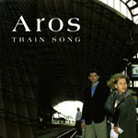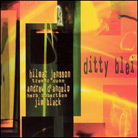July 2004
 With these two discs, the NYC jazz-loft scene finally reaches
high-resolution multichannel SACD. Finding two better choices to introduce that particular
genre of jazz would be a long and difficult search. Don’t let your unfamiliarity with
many of the musicians on either of the two albums dissuade you from giving them a listen.
I too started off giving them a big "Who are they?" After taking a listen,
I’m glad my curiosity won out. All are seasoned veterans of the loft scene, and each
brings something unique to the table -- influences as diverse as mid-period Miles
Davis/Gil Evans, late-period John Coltrane, and Ornette Coleman’s free-jazz
experiments. In addition, both discs add helpings of classical, Spanish, Irish folk, and
Latin music to the mix. Blended together, they combine to make a tasty musical stew. With these two discs, the NYC jazz-loft scene finally reaches
high-resolution multichannel SACD. Finding two better choices to introduce that particular
genre of jazz would be a long and difficult search. Don’t let your unfamiliarity with
many of the musicians on either of the two albums dissuade you from giving them a listen.
I too started off giving them a big "Who are they?" After taking a listen,
I’m glad my curiosity won out. All are seasoned veterans of the loft scene, and each
brings something unique to the table -- influences as diverse as mid-period Miles
Davis/Gil Evans, late-period John Coltrane, and Ornette Coleman’s free-jazz
experiments. In addition, both discs add helpings of classical, Spanish, Irish folk, and
Latin music to the mix. Blended together, they combine to make a tasty musical stew.
For instance, catch the Spanish tinge woven throughout "Road Song" by Aros on Train Song. The experimental jazz element is never far from the surface. Just as you might think you have your bearings, "Four ‘N A Half" transports you onto another plane altogether. Shades of Cecil Taylor and Ornette Coleman hold forth, but with something of a more melodic twist. A powerful bass line helps anchor both tunes. This is truly wonderful stuff. Each tune on Train Song offers something just a tad off kilter to grab and hold your attention. The musicians that make up Aros -- Rob Armos on tenor sax, Marion von Tiezer on piano, John Korsrund on trumpet, Anne Wood on violin, Sven Schuster on contrabass, and Alan Purves on percussion -- all work solidly together to make a musical whole that is very definitely more than the sum of its parts. They weave a tapestry of subtle threads made up of their differing styles into a whole cloth of vast aural pleasure. I found Ms. Wood’s violin to be an especially compelling voice amidst the more traditional jazz instrumentation; Ms. von Tiezer’s classical piano training helps carry the music to a higher plateau. And Purves is more than just a drummer; he’s a true percussionist. If your system’s low-level resolution is up to the task, you’ll appreciate the manner in which he slips the odd wood block, marimba, and assorted bells and whistles (and I mean that literally as well as figuratively) into the mix. Ditty Blei, by guitarist Hilmar Jensson continues along the musical avenue of Train Song, and then paves new paths off it. It’s a more typical jazz setting -- featuring as it does alto sax (Andrew D’Angelo), trumpet (Herb Robertson), bass (Trevor Dunn), drums (Jim Black) and electric guitar (Jensson) -- while, at the same time being more musically adventurous. The initial impression that springs to mind is the influence of John Coltrane’s Impulse period. Both D’Angelo and Robertson growl, squeak, honk and drive their music along, using the rhythm section as the musical equivalent of propulsive rocket fuel. By itself, that simple show of virtuosity would grow cloying in a very short time. Fortunately, Jensson holds tight rein on his bandmates, never allowing a tune to get out of hand, always keeping things within melodic bounds. Two tracks, "Grinning"and "Davu," illustrate how Jensson maintains his mastery over the situation. On ‘Grinning" D’Angelo and Robertson follow their muses wherever they lead and it makes for a wild, adventurous ride. But, as soon as their excursion into excess is over, the extremely melodic "Davu" brings the proceeding back onto terra firma. A pretty, simple tune, "Davu" stands in marked contrast to the freedom displayed on "Grinning." And the whole of Ditty Blei is replete with such contrasts. It’s what makes this album so compelling and interesting musically. I doubt very much if this recording would be anywhere near as interesting as it is if Black did not possess the taste and ability to control the tempo as well as he does. He controls each song skillfully, supporting when asked, driving when needed, but always a part of the group effort. And Jensson, though the nominal leader, is willing to play more of a sideman's role -- he reminds me a great deal of Jim Hall here. If you’re paying attention, you’ll find he’s right there, playing the perfect note at just the right time. Both his handling of the color (there’s no piano to take that role) and his timing are impeccable. I’d like, at this point, to make special note to all those SACD detractors out there who keep pointing to the constant stream of analog reissues and decrying a supposed lack of interesting pure-DSD material. With the release of these two stereo and multichannel hybrid DSD-recorded albums, I do believe it’s time for you to pack up your soapboxes and go home. So there. And even if you’re not looking for hi-rez discs, don’t fear purchasing these albums despite their SACD pedigree. The Red Book CD layer is just fine. Each is fully the equivalent of anything being produced today. But to get the full effect of sound and music recorded on either Train Song or Ditty Blei, you’ll want an SACD player. Both hi-rez layers offer sound that plain-jane CD just can’t touch for fullness, realness, and just plain musicality. And while I could (and do) listen to the stereo layers all day long, the multichannel layers are so very tastefully done that it makes the case for going multichannel in a big way. To deny oneself the opportunity of hearing either of these in that manner would be a crime. If more labels would handle rear-channel information as discretely as Songlines does on these two discs, audiophiles would be lining up to upgrade their systems to multichannel. Based upon my time listening to these two Songlines discs, I would have to say there are only two things that come to mind. First, more -- I want even more musically worthy discs such as these. And second, I would love the chance to experience this music performed in its natural environment. And isn’t that the point of recorded music, to stimulate our desire for hearing it live? Both Train Song and Ditty Blei meet that criterion in spades. Welcome to the loft scene -- and a big thank you to the good folks at Songlines for having the foresight to allow us this glimpse. GO BACK TO: |
 Aros - Train Song
Aros - Train Song Hilmar Jensson - Ditty Blei
Hilmar Jensson - Ditty Blei